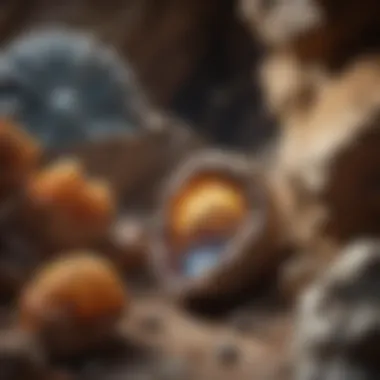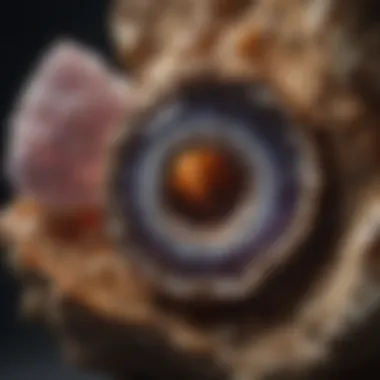Unveiling the Hidden Beauty: A Comprehensive Guide to Discovering Geodes


Rock and Fossil Identification
Embarking on a journey to uncover the hidden beauty of geodes entails a fundamental understanding of rock and fossil identification. Comprehending the various types of rocks and fossils is paramount, as it enables enthusiasts to distinguish between different geological specimens. When scouring remote terrains in search of geodes, one must pay close attention to specific characteristics that indicate the presence of these captivating formations. Tools such as chisels, hammers, magnifying glasses, and UV lights serve as invaluable aids in the identification process, allowing collectors to discern key features and nuances.
Locating Prime Collecting Sites
One of the crucial aspects of geode hunting is identifying prime collecting sites where these geological wonders can be found in abundance. Scouting for locations with a history of geode formation significantly increases the chances of yielding remarkable specimens. Remote areas characterized by unique geological formations, such as limestone deposits or volcanic regions, often harbor an array of geodes waiting to be discovered. Conducting thorough research, consulting geological maps, and seeking guidance from local experts are effective strategies for pinpointing optimal collecting sites.
Techniques for Safely Extracting Specimens
Extracting geodes from their rocky confines requires precision and care to ensure the preservation of their natural beauty. Employing suitable techniques, such as gentle tapping with a chisel or using a rock hammer to delicately crack open geodes, minimizes the risk of damaging the internal crystalline structures. Prioritize safety by wearing protective gear like gloves and safety goggles during the extraction process to prevent accidents and shield oneself from potential hazards.
Preservation and Display Methods
Preserving geodes maintains their aesthetic appeal and geological significance for extended periods. Implementing techniques such as coating specimens with a protective sealant or storing them in airtight containers helps safeguard against environmental degradation and mineral leaching. When it comes to displaying geodes, explore creative ideas like arranging them in shadow boxes, incorporating LED lighting for showcasing their inner beauty, or crafting custom stands to showcase these geological marvels in all their splendor.
Understanding Geological Formations
Delving into the intricate world of geological formations provides insights into the processes that shape our planet and give rise to captivating rock specimens like geodes. Unravel the historical significance of rock formations through studying their mineral composition, sedimentary layers, and the environmental conditions that contributed to their creation. Explore notable discoveries in the field of geology, from groundbreaking fossil finds to extraordinary mineral formations, shedding light on the remarkable accomplishments and advancements in earth sciences.
Introduction
In this segment of our detailed exploration into the captivating world of geodes, we embark on a journey to unveil the hidden beauty these geological marvels hold. Providing a roadmap for rock and fossil enthusiasts, this article serves as a comprehensive guide for those eager to delve into the mysteries of geode hunting. From the rugged terrains where these treasures lie undiscovered to the scientific intricacies behind their formation, we aim to equip you with the knowledge and tools essential for a rewarding geode-hunting expedition.
Understanding Geodes
Definition of Geodes
Diving into the essence of geodes, we unravel the specific characteristics that define these mesmerizing formations. Geodes, with their hollow interiors lined with crystals or minerals, stand out as unique geological wonders. Their allure lies in the hidden beauty encased within rough exteriors, making them a popular choice for rock collectors seeking natural art pieces. Despite the challenges geodes pose in extraction, the excitement of uncovering their inner splendor drives collectors worldwide to seek out these enigmatic formations.
Formation Process
Exploring the intricate process behind geode formation sheds light on the geological forces at play. From mineral deposition to crystallization mechanisms, each step contributes to the awe-inspiring structure of geodes. Understanding the formation process not only enhances our appreciation for these natural creations but also guides us in selecting prime locations for geode discovery. By comprehending the scientific complexities underlying their formation, collectors can optimize their search efforts and increase the chances of unearthing spectacular specimens.
Distinctive Features
The distinct features of geodes set them apart as prized geological treasures. With their crystalline interiors, geodes offer a mesmerizing display of colors and shapes that vary depending on the minerals present. The unique appeal of geodes lies in their ability to surprise and astound, with each specimen unveiling a one-of-a-kind crystalline landscape. While the charm of geodes is undeniable, collectors must navigate potential pitfalls such as delicate structures and fragile crystals during extraction to preserve the beauty within.


Significance of Geodes
Historical and Cultural Value
Delving into the historical and cultural significance of geodes unveils their enduring appeal across civilizations. From ancient beliefs in their mystical properties to modern-day artistic inspirations, geodes have held a special place in human history. Their presence in myths, art, and rituals reflects the deep-rooted fascination with these natural marvels, making them more than just geological formations but cultural symbols embodying beauty and mystery.
Scientific Importance
Embarking on a scientific journey, we unravel the valuable insights geodes offer to the field of geology. By studying the minerals within geodes and the conditions conducive to their formation, scientists gain valuable knowledge about the Earth's processes. Geodes serve as geological time capsules, providing clues to past environmental conditions and mineral deposition mechanisms. Their scientific significance extends beyond aesthetic appreciation, offering a window into the Earth's geological history and evolution over eons.
Geode Formation
Geode formation plays a pivotal role in our exploration of geodes. Understanding the intricate processes behind geode formation not only enriches our knowledge but also enhances our appreciation for these geological marvels. By delving into the natural phenomena that lead to the creation of geodes, we gain insights into the fascinating world of mineral deposition and crystallization mechanisms. These processes are fundamental to the development of geodes and contribute significantly to their unique features and formations. Studying geode formation opens a gateway to a deeper understanding of the earth's geological wonders and the forces at play beneath its surface.
Natural Processes
Mineral Deposition
Mineral deposition is a cornerstone of geode formation, dictating the composition and appearance of these natural treasures. The specific aspect of mineral deposition lies in its ability to gradually build up mineral layers within cavities, giving rise to the enchanting crystal formations found in geodes. The key characteristic of mineral deposition is its role in shaping the internal structure of geodes, resulting in intricate patterns and vibrant colors. This process is favored in our discussion due to its essential role in creating the visual allure that defines geodes. Understanding mineral deposition allows us to appreciate the geological artistry embedded within these captivating formations.
Crystallization Mechanisms
Crystallization mechanisms drive the formation of crystals within geodes, adding a mesmerizing dimension to their aesthetic appeal. The uniqueness of crystallization mechanisms lies in their ability to transform dissolved minerals into solid crystal structures, forming the crystalline interiors characteristic of geodes. The key characteristic of crystallization mechanisms is their role in shaping the intricate patterns and textures of crystals within geodes, enhancing their allure and beauty. This process is integral to our discussion as it sheds light on how geodes achieve their mesmerizing crystal formations. Exploring crystallization mechanisms offers a glimpse into the remarkable natural processes that culminate in the creation of these geological wonders.
Geological Conditions
Types of Rock Formations
The types of rock formations where geodes are found greatly influence their formation and characteristics. Understanding the diverse rock formations that host geodes is essential for rock enthusiasts seeking to uncover these hidden treasures. The key characteristic of rock formations is their role in providing the necessary environment for geodes to form, offering cavities and conditions conducive to mineral deposition and crystallization. This aspect is instrumental in our discussion as it highlights the interplay between geology and geode formation. By studying different types of rock formations, we gain insight into the geological diversity that gives rise to a variety of geode types and structures.
Environmental Factors
Environmental factors play a significant role in shaping the formation of geodes, influencing their size, quality, and distribution. The specific aspect of environmental factors lies in their impact on the mineral content, temperature, and pressure conditions necessary for geodes to develop. The key characteristic of environmental factors is their ability to create favorable conditions for geode formation, determining the unique properties of geodes in different locations. This aspect is paramount to our discussion as it underscores the environmental variability that contributes to the diversity of geode formations worldwide. Exploring the influence of environmental factors provides valuable insights into the complex interplay between natural elements and geode development.
Popular Geode Locations
In the exploration of geodes, understanding popular geode locations becomes a crucial aspect. These locations are key to unearth the hidden beauty locked within these geological formations. By focusing on popular geode locations, enthusiasts can enhance their chances of discovering remarkable specimens and expanding their knowledge of these natural wonders.


United States
Kentucky
Kentucky stands out as a remarkable destination for geode enthusiasts. Its rich geological landscape offers a diverse range of geode formations, attracting collectors and researchers alike. The key characteristic of Kentucky lies in its abundance of geode-rich areas, providing ample opportunities for discovery and study. The unique feature of Kentucky is its variety of geode sizes and colors, offering collectors a wide selection to choose from. While Kentucky presents fantastic geode-hunting prospects, some challenges include access limitations and rigorous terrain conditions.
Iowa
Iowa, another notable geode location, contributes significantly to the overall geode hunting experience. Its geode fields are renowned for their unique crystal formations, making it a popular choice for rock enthusiasts. The key characteristic of Iowa is its geode clusters, which showcase intricate patterns and structures. Collectors are drawn to Iowa for its geological diversity and the chance to find rare geode specimens. However, the remote locations and weather fluctuations can pose challenges for those exploring Iowa's geode deposits.
Nevada
Nevada offers a distinctive geode hunting experience, blending adventure with geological wonders. The key characteristic of Nevada's geode locations is the presence of large geodes embedded within ancient rock formations. Collectors are attracted to Nevada for its potential to discover sizable and pristine geodes. The unique feature of Nevada is its geological history, reflected in the quality of geodes found in the region. While Nevada presents exciting opportunities for geode enthusiasts, navigating the rugged terrain and extreme temperatures can be demanding.
Europe
Spain
Spain emerges as a captivating geode location, enriching the geode hunting landscape with its unique characteristics. The key feature of Spain lies in its diversity of geode types, including amethyst and quartz formations. Spain is a beneficial choice for geode hunting due to its accessible locations and geological beauty. The country's unique feature is its cultural significance, with geodes playing a role in local traditions and folklore. Despite its attractiveness, encountering tourists and adhering to conservation regulations are aspects to consider when exploring Spain's geode sites.
Hungary
Hungary provides a compelling setting for geode hunting enthusiasts, offering a blend of history and natural beauty. The key characteristic of Hungary is its geode-rich regions, where collectors can find an array of crystal formations. Hungary's advantageous aspect is its geological diversity and the presence of unique geode specimens. The country's unique feature is its thermal spring geodes, adding an element of rareness to the collecting experience. While Hungary presents exciting opportunities, being mindful of environmental protection and limited access to certain sites is essential.
Romania
Romania stands out as a hidden gem for geode enthusiasts, promising a treasure trove of unique geological discoveries. The key characteristic of Romania is its exceptional variety of geode formations, ranging from calcite to agate structures. Romania's beneficial aspect is its unexplored geode sites, providing an opportunity for collectors to make fresh finds. The country's unique feature is its untouched natural beauty, attracting adventurers seeking pristine geode specimens. When exploring Romania's geode locations, staying informed about regulations and respecting the environment are vital considerations.
Tools and Techniques
In the pursuit of uncovering the hidden beauty of geodes, the utilization of proper tools and techniques stands paramount. These instruments are not merely objects but rather extensions of the geode hunter, assisting in the meticulous extraction process. Each tool serves a distinct purpose, contributing to the overall success of the geode hunting endeavor. It is essential to understand the significance of employing the right tools and techniques to ensure a fruitful exploration.
Essential Equipment
Rock Hammer
The rock hammer emerges as a fundamental tool in geode exploration due to its robust design and versatility. This tool, characterized by a sharp pick end and a flat hammering surface, aids in breaking through tough rock surfaces to reveal hidden geodes. The rock hammer's durability and ergonomic handle make it a popular choice among geode hunters, providing both comfort and efficiency during extraction. Its unique feature lies in its dual functionality, allowing users to chisel and break rocks with precision, enhancing the chances of discovering pristine geodes.


Chisel
Complementing the rock hammer, the chisel plays a vital role in delicately extracting geodes from their rocky encasements. Equipped with a sharp edge, the chisel assists in precisely carving around geodes to prevent damage during excavation. The key characteristic of the chisel is its sharpness, allowing for intricate maneuvering in tight spaces to release geodes intact. While the chisel's pointed end aids in precise detailing work, its flat side proves advantageous for leveraging against rock surfaces to separate geodes effectively.
Safety Gear
Considering the potential risks associated with geode extraction, the utilization of proper safety gear is imperative. Safety gear, including gloves, protective eyewear, and sturdy footwear, ensures the geode hunter's well-being during excavation activities. The key characteristic of safety gear lies in its capacity to safeguard against cuts, debris, and eye injuries, mitigating potential hazards in the field. While safety gear may sometimes feel restrictive, its advantages in providing adequate protection far outweigh any minor discomfort, prioritizing the welfare of the geode enthusiast.
Extraction Methods
Quarry Mining
Quarry mining presents itself as a structured approach to geode extraction, wherein geologists and miners strategically access geode-rich regions within quarries. The key characteristic of quarry mining lies in its organized nature, allowing for systematic exploration of geode deposits. This method's advantage lies in the extensive access it provides to geode clusters embedded within rock formations, offering a higher likelihood of discovering rare specimens. Despite its efficiency, quarry mining requires adherence to safety protocols and environmental regulations to ensure responsible extraction practices.
Field Excavation
In contrast, field excavation entails a more hands-on approach to geode hunting, involving manual exploration of terrestrial landscapes. The key characteristic of field excavation is its immersive nature, requiring geode hunters to navigate diverse terrains in search of hidden treasures. This method's advantage lies in the direct engagement with the environment, fostering a deeper connection to the geodes discovered. While field excavation offers a sense of adventure and exploration, it demands careful navigation of potentially rugged terrains and adherence to ethical collecting guidelines to preserve natural landscapes.
Ethical Considerations
In the realm of geode exploration, ethical considerations play a pivotal role in ensuring the preservation and sustenance of these geological marvels for future generations. By adhering to ethical guidelines, rock enthusiasts contribute to the conservation of natural habitats and maintain the delicate balance of ecosystems where geodes are found. This article emphasizes the significance of ethical conduct in rock-hunting endeavors, shedding light on the essential values that underpin responsible geode collection.
Preservation Efforts
Leave No Trace Principles
Delving into the realm of Leave No Trace Principles, it becomes apparent that these directives advocate for minimal impact practices while engaging with nature. The core essence of Leave No Trace lies in leaving natural spaces in the same pristine condition as they were found, promoting environmental stewardship among geode enthusiasts. This ethos aligns well with the essence of rock hunting, as it fosters a sense of responsibility towards preserving these geological treasures for future generations. The unique feature of Leave No Trace Principles lies in its comprehensive approach towards sustainable outdoor ethics, urging individuals to minimize their footprint and respect the integrity of natural environments.
Responsible Collecting
On the other hand, Responsible Collecting encapsulates the conscientious extraction of geodes while prioritizing the conservation of geological formations. This facet underscores the importance of selective collection methods that do not compromise the ecological balance of geode habitats. By advocating for mindful practices, Responsible Collecting ensures that the splendor of geodes endures without causing harm to the environment. Its distinctive characteristic lies in fostering a sense of custodianship towards geode formations, encouraging enthusiasts to engage with these natural wonders in a sustainable and considerate manner.
Conclusion
Geodes, these mesmerizing geological marvels, hold a wealth of significance both historically and scientifically. The Conclusion section of this guide encapsulates the essence and importance of understanding and appreciating geodes. By delving into the aesthetic appeal and educational value of geodes, readers can develop a holistic perspective on these fascinating formations. Exploring the captivating beauty and the educational insights geodes offer can truly enrich one's rock-hunting journey. With geodes being not just visually stunning but also serving as valuable educational tools, the Conclusion emphasizes the multifaceted nature of these geological wonders, urging enthusiasts to appreciate them both aesthetically and intellectually.
Appreciating Geodes
Aesthetic Appeal
The Aesthetic Appeal of geodes is a core aspect that draws enthusiasts to these natural treasures. The captivating beauty and unique patterns found within geodes contribute significantly to their allure. The intricate crystalline structures and vibrant hues encapsulated within the unassuming exterior of geodes make them a popular choice among rock and fossil collectors. Despite their rugged exteriors, the dazzling crystals hidden within enchant individuals, making the discovery of a geode a truly rewarding experience. The Aesthetic Appeal of geodes adds a layer of excitement to the rock-hunting adventure, offering a visual feast that leaves enthusiasts in awe of nature's artistry.
Educational Value
The Educational Value of geodes extends beyond their beauty, serving as valuable learning resources for enthusiasts of all ages. Delving into the geological processes responsible for geode formation provides a hands-on lesson in earth sciences. Studying the crystalline structures and mineral compositions encapsulated within geodes offers insights into mineralogy and geology. By unlocking the educational potential of geodes, enthusiasts can deepen their understanding of geological concepts and appreciate the intricate workings of our planet. The Educational Value of geodes not only fosters a passion for earth sciences but also instills a sense of wonder and curiosity about the natural world, making them invaluable educational tools for aspiring geologists and rock enthusiasts.







